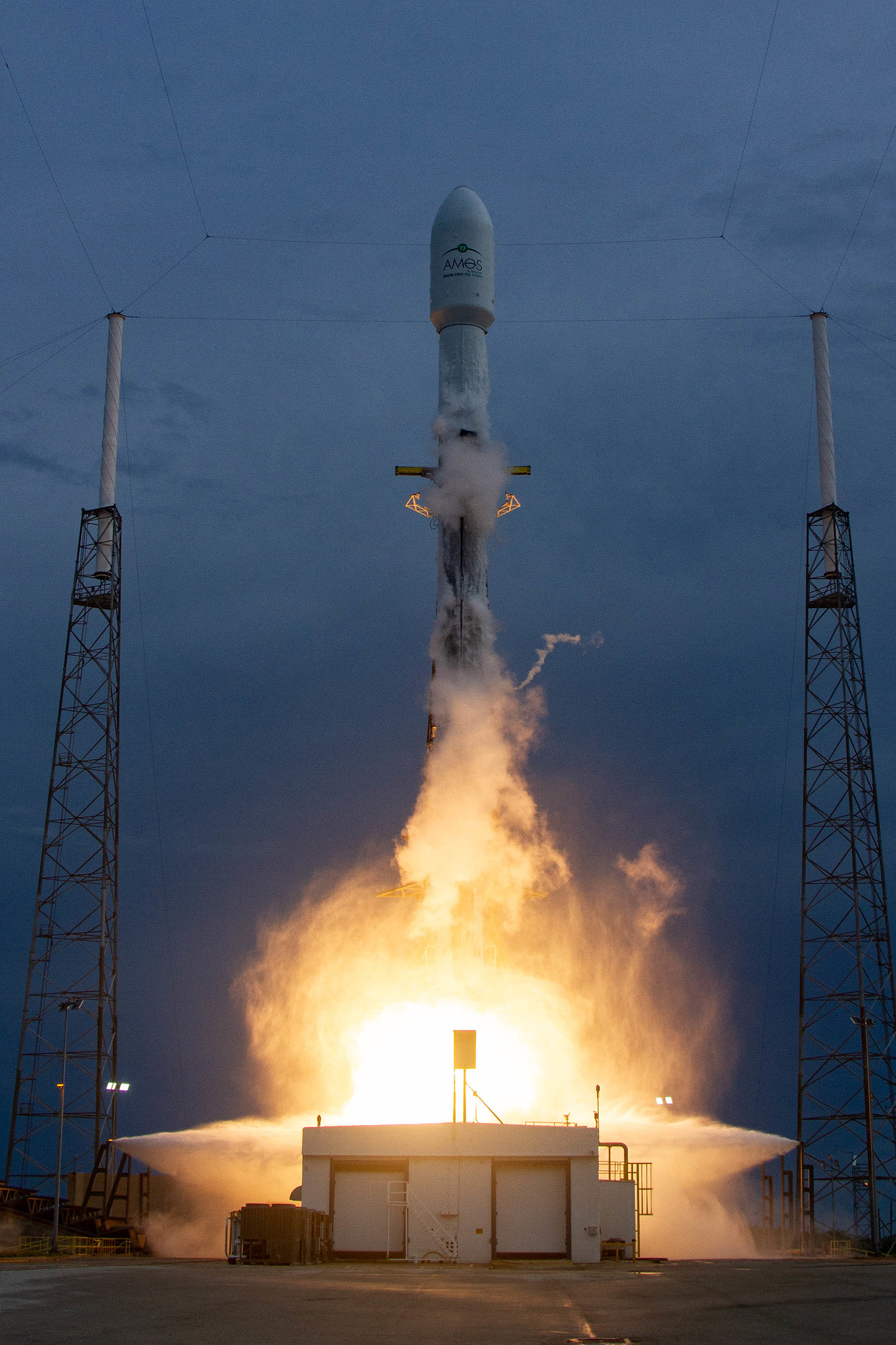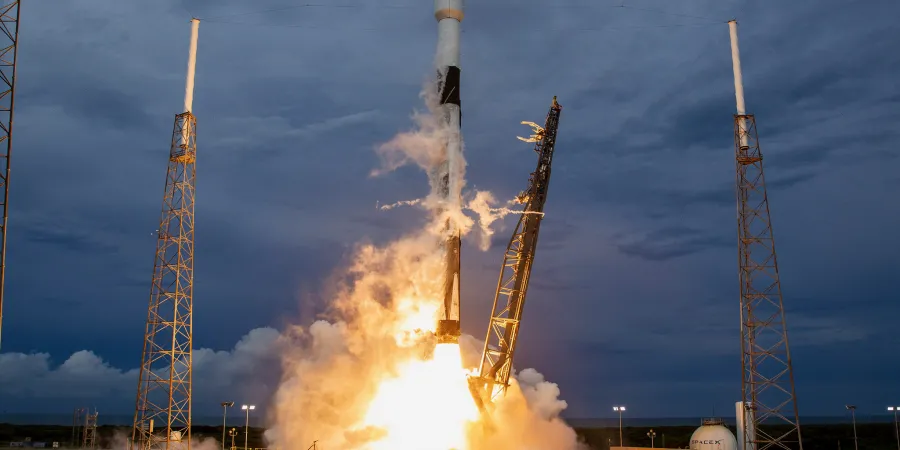Israeli Amos-17 Communications Satellite Launched into Space
Spacecom’s Amos-17 satellite was successfully launched overnight Wednesday (Israel time) from Cape Canaveral, Florida, on board a SpaceX Falcon 9 rocket. The satellite is expected to operate for 20 years and provide communications services to sub-Saharan Africa as well as other regions in Europe and the Middle East
IsraelDefense
| 07/08/2019
SpaceX’s Falcon 9 rocket successfully lifted off early Wednesday (02:23, Israel time) from Space Launch Complex 40 at Cape Canaveral Air Force Station, Florida, carrying the Amos-17 digital communications satellite for Spacecom.
Amos-17 will run a sequence of in-orbit tests in the coming weeks, expected to take approximately three months, prior to beginning commercial operations.
The Amos-17 satellite was designed by Spacecom using Boeing’s advanced digital payload technology to provide increased connectivity to Africa. With its extensive abilities, flexibility, and reliability, Amos-17 is said to support growth in a variety of broadcast, broadband, mobility, and data services throughout the African continent. It will be deployed to the 17°E orbital position, right over central Africa, to optimize service in the region. It is planned to be in operation for a minimum of 20 years.
Amos-17 will operate in the C, Ku and Ka bands with a digital channelizer to provide fixed high throughput (HTS) C-band coverage to Africa, steerable HTS Ka-band coverage to anywhere from China to Brazil, and extensive Ku-band coverage throughout Africa with additional coverage in Europe, the Middle East, China, and India.
The satellite’s digital processing capabilities provide connectivity between all of Amos-17’s beams in all available bands in any combination. These capabilities also support suppression of interference, flexible capacity allocation, and other digital processing features for improved service. Additionally, all command and control channels, as well as telemetry, are encrypted for maximum security.

The launch of Amos-17 was initially scheduled for Sunday evening (local time), but postponed after a “suspect valve” was identified in one of the SpaceX Falcon 9 launch vehicle's engines. After additional tests of the launch site were successfully carried out, the rearranged satellite launch was executed without fault.
“Amos-17 places us directly into the exciting growth of Africa’s Sub-Saharan vibrant markets,” said Spacecom CEO and President David Pollack following the launch. “As a leading multi-regional satellite operator, Spacecom is introducing the most technologically advanced satellite with HTS beams to service Africa where Amos-17 will deliver a large selection of services to a variety of broadcast, broadband, and telecom clients.”
Spacecom says it has a sales backlog of $58 million for communications services to the African market by Amos-17 and for other services and it expects to sign more deals in the future.
***
Photo: SpaceX
[Sources: SpaceX, Spacecom, The Jerusalem Post]
Spacecom’s Amos-17 satellite was successfully launched overnight Wednesday (Israel time) from Cape Canaveral, Florida, on board a SpaceX Falcon 9 rocket. The satellite is expected to operate for 20 years and provide communications services to sub-Saharan Africa as well as other regions in Europe and the Middle East
SpaceX’s Falcon 9 rocket successfully lifted off early Wednesday (02:23, Israel time) from Space Launch Complex 40 at Cape Canaveral Air Force Station, Florida, carrying the Amos-17 digital communications satellite for Spacecom.
Amos-17 will run a sequence of in-orbit tests in the coming weeks, expected to take approximately three months, prior to beginning commercial operations.
The Amos-17 satellite was designed by Spacecom using Boeing’s advanced digital payload technology to provide increased connectivity to Africa. With its extensive abilities, flexibility, and reliability, Amos-17 is said to support growth in a variety of broadcast, broadband, mobility, and data services throughout the African continent. It will be deployed to the 17°E orbital position, right over central Africa, to optimize service in the region. It is planned to be in operation for a minimum of 20 years.
Amos-17 will operate in the C, Ku and Ka bands with a digital channelizer to provide fixed high throughput (HTS) C-band coverage to Africa, steerable HTS Ka-band coverage to anywhere from China to Brazil, and extensive Ku-band coverage throughout Africa with additional coverage in Europe, the Middle East, China, and India.
The satellite’s digital processing capabilities provide connectivity between all of Amos-17’s beams in all available bands in any combination. These capabilities also support suppression of interference, flexible capacity allocation, and other digital processing features for improved service. Additionally, all command and control channels, as well as telemetry, are encrypted for maximum security.

The launch of Amos-17 was initially scheduled for Sunday evening (local time), but postponed after a “suspect valve” was identified in one of the SpaceX Falcon 9 launch vehicle's engines. After additional tests of the launch site were successfully carried out, the rearranged satellite launch was executed without fault.
“Amos-17 places us directly into the exciting growth of Africa’s Sub-Saharan vibrant markets,” said Spacecom CEO and President David Pollack following the launch. “As a leading multi-regional satellite operator, Spacecom is introducing the most technologically advanced satellite with HTS beams to service Africa where Amos-17 will deliver a large selection of services to a variety of broadcast, broadband, and telecom clients.”
Spacecom says it has a sales backlog of $58 million for communications services to the African market by Amos-17 and for other services and it expects to sign more deals in the future.
***
Photo: SpaceX
[Sources: SpaceX, Spacecom, The Jerusalem Post]



